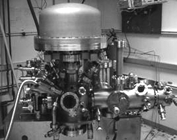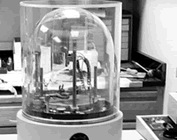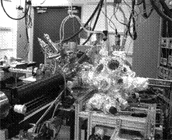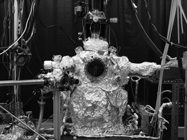|
Projects below represent the major focus of research in the Hemminger group. For each category we include a brief description of the research overview as well as the instrumentation we employ for the projects.
 |
ION PROFILES AT AQUEOUS INTERFACES |
 |
 We employ x-ray photoelectron spectroscopy (XPS) to probe the distributions of halide ions at interfaces. These fundamental studies have a profound impact on the understanding of atmospheric interfacial chemistry.
We employ x-ray photoelectron spectroscopy (XPS) to probe the distributions of halide ions at interfaces. These fundamental studies have a profound impact on the understanding of atmospheric interfacial chemistry.
About x-ray photoelectron spectroscopy (XPS)
This gives a nice overview of the XPS technique. A worthwhile read for anyone who is breathing.
Partitioning of ions at liquid surfaces
In collaboration with the Advanced Light Source (ALS) at Lawrence Berkeley National Laboratory as well as Berliner Elektronen-Speicherring Gesellschaft für Synchrotronstrahlung (BESSY), we use XPS to probe the ion concentration
as a function of depth from the surface of liquids.
The effect of organic surfactants on ion surface partitioning
Some text goes here about this project. Yay text.
Reactions of OH radical with ions at surfaces
Some text goes here about this project. Yay text.
Panorama of our XPS Laboratory
Follow this link to a full 360 degree panorama of our XPS laboratory. Requires Apple QuickTime VR 5 or later
(comes with many recent complete installations of QuickTime).

 |
LINEAR NANOPARTICLE ARRAYS |
 |
 We grow metal and metal oxide nanoparticles on the steps of highly oriented pyrolytic graphite (HOPG) for fundamental studies related to spectroscopy, catalysis, and solar cells.
We grow metal and metal oxide nanoparticles on the steps of highly oriented pyrolytic graphite (HOPG) for fundamental studies related to spectroscopy, catalysis, and solar cells.
Physical Vapor Deposition (PVD)
This hunk a junk allows us to grow metal and metal oxide nanoparticles on graphite in addition to general thin film deposition.
Surface Enhanced Raman Spectroscopy (SERS) on Silver Nanoparticle Arrays
Silver nanoparticle arrays enhance applied electromagnetic fields that enable SERS-based investigations. Using surface assembled thiophenol as a Raman probe, these linear arrays exhibit highly polarization-dependent surface enhanced Raman scattering. When light is polarized along the axis of the arrays, the enhanced Raman scattering signal is significantly stronger than Raman scattering when the incident light is polarized perpendicular to the axis of the arrays.
Surface Plasmon-Enhanced Photoluminescence of Hybrid Semiconductor Nanowires
Starting with the silver nanoparticle arrays mentioned above, we further deposit semiconductor materials like CdS or CdSe forming core/shell hybrid nanowires. The coupling between the semiconductor shells and the surface plasmon supported by the metal cores yields enhanced photoluminescence.
Photodeposition of Platinum and Gold Nanoparticles onto Titanium Dioxide Nanoparticle Arrays
Upon the absorption of ultraviolet light by titanium dioxide nanoparticles, photogenerated electrons trapped at the metal oxide surface reduce and deposit Pt or Au nanoparticles. Disperse metal nanoparticles on TiO2 permit the investigation of the heterogenous and photocatalytic properties of the nanocomposites.
Growth of Pyrite from Iron Oxide Nanoparticle Arrays
Hydrogen sulfide or sulfur annealing can convert iron oxide nanoparticles into pyrite that act as seeds to grow pyrite films using chemical vapor depositon (CVD). Pyrite thin films show promise as a cheap and viable photovoltaic.
 |
ORGANIC DEHYDROGENATION ON PLATINUM NANOPARTICLES |
 |
This block of text is for the title of this section which I have yet to write. We use scanning tunneling microscopy (STM) to image the reaction and high resolution electron energy loss spectroscopy (HREELS) to provide vibrational spectroscopy of these reactions.
 About scanning tunneling microscopy (STM)
About scanning tunneling microscopy (STM)
This gives a nice overview of the STM technique. A worthwhile read for anyone who is breathing.
High resolution mass spectrometry of carbene dehydrogenation
This text is a place holder for item one. So is this text. Yay. Text is fun. On the other hand, this text is here simply because I'm
on a roll.
Panorama of our STM Laboratory
Follow this link to a full 360 degree panorama of our STM laboratory. Requires Apple QuickTime VR 5 or later
(comes with many recent complete installations of QuickTime).
 About electron energy loss spectroscopy (EELS), and high-resolution EELS (HREELS)
About electron energy loss spectroscopy (EELS), and high-resolution EELS (HREELS)
This gives a nice overview of these techniques. A worthwhile read for anyone who is breathing.
Panorama of the HREELS and TPD Laboratory
Follow this link to a full 360 degree panorama of the laboratory that contains our HREELS instrument.
Requires Apple QuickTime VR 5 or later
(comes with many recent complete installations of QuickTime).

 |
WATER INTERACTIONS WITH ORGANIC SURFACES |
 |
Aerosol surfaces contain a high fraction of organic molecules which are aged by photochemical and radical oxidation reactions in the atmosphere. We employ temperature programmed desorption (TPD) spectroscopy to characterize the fundamental interaction between water and mimetic organic aerosol surfaces.
 About temperature programmed desorption (TPD) spectroscopy
About temperature programmed desorption (TPD) spectroscopy
This gives a nice overview of TPD. A worthwhile read for anyone who is breathing.
Water interaction with a mixed monolayer
Mixed self-assembled monolayers of hydrophilic and hydrophobic character mimic the surfaces of processed, atmospherically
aged aerosol. We characterize the interaction of these monolayers with water to determine how the hydrophilic and hydrophobic
domain size affects the water binding.
Characterization of thiol monolayer formation on gold
Formation of self-assembled thiol monolayers on gold is a well-known technique in many fields of science. Most of these reactions
are performed in solution (e.g. ethanol), but questions remain regarding thiol monolayer formation from gas-phase adsorbates. We
are presently developing experiments to elucidate this mechanism.
Panorama of the HREELS and TPD Laboratory
Follow this link to a full 360 degree panorama of the laboratory that contains our TPD instrument.
Requires Apple QuickTime VR 5 or later
(comes with many recent complete installations of QuickTime).

|





